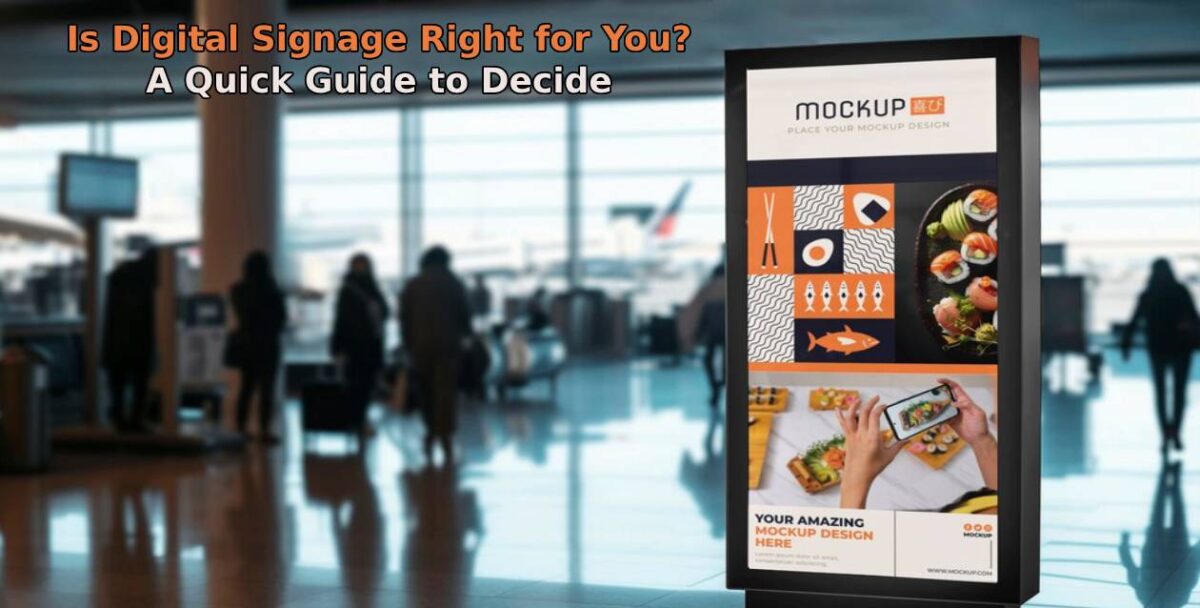Is Digital Signage Right for You? A Quick Guide to Decide

In today’s fast-paced world, businesses constantly seek innovative ways to engage customers, enhance brand awareness, and ultimately drive sales. Digital signage has emerged as a powerful tool in this pursuit, offering a captivating alternative to traditional static displays.
But before you jump on board the digital signage bandwagon, it’s crucial to determine if it’s the right fit for your specific business needs.
This quick guide will help you navigate your decision-making process and determine if digital signage can be your secret weapon for success.
Understanding Your Goals:
The first step is to clearly define your goals and objectives. What are you hoping to achieve with digital signage? Here are some common goals businesses aim for:
Increased Sales and Revenue:
Do you want to promote specific products, advertise special offers, or showcase new arrivals to boost sales?
Enhanced Brand Awareness:
Is your objective to build brand recognition, solidify your brand identity, or communicate your company values to customers?
Improved Customer Engagement:
Do you want to capture attention, create a more engaging customer experience, or streamline in-store wayfinding?
Effective Communication:
Is your goal to disseminate real-time information like announcements, safety protocols, or upcoming events to customers or employees?
Once you have a clear understanding of your goals, you can assess if digital signage aligns with those objectives.
Evaluating Your Business Environment:
Next, consider your current business environment and how digital signage can integrate seamlessly. Here are some factors to consider:
Physical Space and Layout:
Do you have adequate space for digital displays strategically positioned for optimal customer visibility? Consider foot traffic patterns and high-impact locations for maximum exposure.
Target Audience:
Who are your primary customers? Understanding their demographics and digital adoption habits helps determine if they are receptive to engaging with information on digital displays.
Existing Infrastructure:
Does your business have the necessary infrastructure, such as internet connectivity and content management systems, to support digital signage effectively?
The Advantages of Digital Signage: A Compelling Case
If your goals and environment align with digital signage capabilities, it offers a multitude of benefits:
Captivating Content and Dynamic Engagement:
Digital signage goes beyond static displays. Create eye-catching content with vibrant visuals, engaging videos, and even interactive elements to grab attention and keep customers hooked.
Enhanced Brand Storytelling:
Digital signage empowers you to tell your brand story in a compelling way. Showcase your company values, highlight your unique selling proposition, and connect with customers on an emotional level. This fosters brand loyalty and a strong brand identity.
Targeted Marketing and Sales Promotion:
Promote specific products or services with targeted advertising displayed at the right time. Highlight special offers, showcase product features effectively, and ultimately encourage purchase decisions.
Improved Communication and Information Sharing:
Digital signage offers a dynamic platform to communicate with your customers and employees in real-time. Display announcements, upcoming events, or store policies for clear and readily accessible information.
Streamlined Wayfinding and Enhanced Customer
Experience:
Especially in large or complex spaces, digital signage can provide clear wayfinding information, minimizing confusion and frustration for customers. This translates to a more enjoyable and efficient overall experience.
Flexibility and Cost-Effectiveness:
Compared to traditional static displays, digital signage offers unmatched flexibility. Content can be easily updated remotely, allowing for real-time campaign changes or adjustments based on customer behavior. This eliminates the need for costly reprints and ensures long-term cost-effectiveness.
Digital Signage Might Not Be for Everyone: Assessing Limitations
While digital signage holds immense potential, it’s essential to acknowledge limitations:
Initial Investment:
Although cost-effective in the long run, the initial investment for hardware, software, and content creation can be higher compared to basic static displays.
Technical Expertise:
Managing a advertising display network may require some technical expertise for installation, content creation, and ongoing maintenance.
Choosing the Right Digital Signage Solution
If, after careful consideration, advertising display aligns with your goals and environment, the next step is choosing the right solution.
Display Size and Resolution:
Consider the viewing distance and desired level of detail. Larger screens with higher resolutions are ideal for showcasing intricate information or multiple elements simultaneously.
Content Management System (CMS):
A user-friendly CMS allows for easy content creation, scheduling, and remote management of your advertising display network.
Durability and Environmental Considerations:
Choose displays suitable for your environment. For high-traffic areas or dusty environments, consider displays with scratch-resistant surfaces and sealed enclosures.
Budget and Return on Investment (ROI):
Evaluate the long-term cost-effectiveness based on your projected return on investment (ROI). Digital signage’s revenue-generating potential through increased sales and brand awareness should be factored into the cost equation.
Conclusion:
Advertising display can be a powerful tool for businesses seeking to enhance customer engagement, boost sales, and build brand awareness. However, the decision to integrate it should be a strategic one.
By carefully considering your goals, business environment, and potential limitations, you can determine if digital signage is the right fit for your needs.
Embrace the power of this technology, but do so strategically, and unlock its potential to transform your business into a more dynamic and customer-centric operation.











